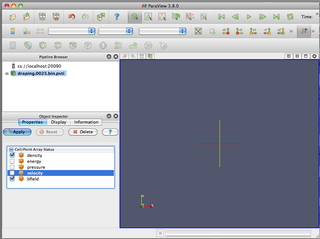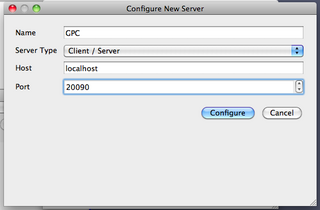Using Paraview
ParaView is a powerful, parallel, client-server based visualization system that allows you to use SciNet's GPC nodes to render data on SciNet, and manipulate the results interactively on your own desktop. To use the paraview server on SciNet is much like using it locally, but there is an additional step in setting up a connection directly between your desktop and the compute nodes.
Installing ParaView
To use Paraview, you will have to have the client software installed on your system; you will need ParaView from the Paraview website. Binaries exist for Linux, Mac, and Windows systems. The client version must exactly match the version installed on the server, currently 3.12 or 3.14.1. The client version has all the functionality of the server, and can analyze data locally.
SSH Forwarding For ParaView
To interactively use the ParaView server on GPC, you will have to work some ssh magic to allow the client on your desktop to connect to the server through the scinet login nodes. The steps required are
- Have an SSH key that you can use to log into SciNet
- Log into the head node that you'll be using the server on
- (Mac or Linux): Edit your local ~/.ssh/config to enable forwarding to that node
- Start ssh forwarding
- Start server
- Connecting client and server
SSH Keys
To be able to log into the compute nodes where ParaView will be running, you'll have to have an SSH key set up, as password authentication won't work. Our SSH Keys and SciNet page describes how to do this.
Log into node
The first thing to do is to go to the node from which you'll start the ParaView server. This is typically done by starting an interactive job on the GPC, perhaps on the debug or largemem queues. Paraview can in principle make use of as many nodes as you throw at it. So one might begin jobs as below:
qsub -l nodes=1:ppn=16,walltime=1:00:00 -q largemem -I
qsub -l nodes=2:ppn=8,walltime=1:00:00 -q debug -I
Once this job has started, you'll be placed in a shell on the head node of the job; typing `
hostname
' will tell you the name of the host, eg
$ hostname gpc-lrgmem01
or
$ hostname gpc-f107n045
you will need this hostname in the following steps.
Edit ssh config (MacOS/Linux)
You will now need to edit your ssh config to allow ssh forwarding so that you can seemingly connect directly to the compute node above. Add the following lines to your ~/.ssh/config file in MacOS or Linux; windows users will have to consult their ssh client's documentation as to how to implement the forwarding:
Host gpc_gw HostName login.scinet.utoronto.ca User [username] LocalForward 20080 [hostname]:22 LocalForward 20090 [hostname]:11111 Host gpcnode HostName localhost HostKeyAlias gpcnode User [username] Port 20080
Replace [username] with your username, and [hostname] with the name of the host from the previous step. This sets two ssh port forwards; one to port 11111 of the compute nodes, which is needed by ParaView; and one is just the usual SSH port 22, which can be used for testing. In future runs of the server, only the hostname in the first stanza needs to be changed.
Edit ssh config (Windows, Cygwin)
If you have Cygwin X installed on Windows, including the openssh package, take the following steps. First run in your Cygwin Bash Shell:
$ ssh-user-config
There is no need to create any of the keys, but this will create the ssh directory where you need to put the config file.
Next, go to the directory cygwin\home\[username]\.ssh\, where username is your computer login name. In this directory, create a file called config containing the code from the previous section, with the stanzas replaced by the appropriate host- and username. Make the file read-only. The ssh port forwarding is now set up. Open a Cygwin Bash Shell and follow the rest of the instructions below.
Start SSH port forwarding
Once the ssh configuration is set, the port forwarding can be started with the command (on your desktop)
$ ssh -N gpc_gw
this command will not return anything until the forwarding is terminated, and will just look like it's sitting there. To make sure the port forwarding is working correctly, in another window try sshing directly to the compute node from your desktop:
$ ssh gpcnode
and this should land you directly on the compute node. If it does not, then something is wrong with the ssh forwarding.
Start Server
Now that the tunnel is set up, on the compute node you can start the paraview server. To do this, you will have to have the following modules loaded:
$ module load Xlibraries intel gcc python intelmpi paraview
(You can replace intelmpi with openmpi, and of course any module that is already loaded does have to be loaded again.)
Then start the paraview server with the intel mpirun as with any MPI job:
$ mpirun -np [NP] pvserver --use-offscreen-rendering
where NP is the number of processors; 16 processors per node on the largemem nodes, or 8 per node otherwise.
Once running, the ParaView server should output
Listen on port: 11111 Waiting for client...
Connect Client and Server
Once the server is running, you can connect the client. Start the ParaView client on your desktop, and choose File->Connect. Click `Add Server', give the server a name (say, GPC), and give the port number 20090. The other values should be correct by default; host is localhost, and the server type is Client/Server. Click `Configure'.
On the next window, you'll be asked for a command to start up the server; select `Manual', and ok.
In future runs, you'll be able to re-use this server, even if the host is different, because the correct host will be set in your .ssh/config.
Once the server is selected, click `Connect'. On the compute node, the server should respond `Client connected'. In the client window, when you (for instance) select File->Open, you will be seeing the files on the GPC, rather than the local host.
From here, the ParaView Wiki can give you instructions as to how to plot your data.

